Drones vs Fighter Jets : Who's the True Ace?
A brief case study using the Russia-Ukraine, Israel-Iran and India-Pakistan military operations.
After a pause of two years, I have decided to bring back this newsletter, coinciding with Boeing mulling restarting its C-17 Globemaster III production line. During the two-year vacuum, I repeatedly tried to bring you the latest military aviation updates via Fox Two: Aviation and Beyond, but work demands made it nearly impossible for me to put on the thinking hat. That has changed now and so has the world order. There are more wars ongoing: Russia and Ukraine are still at it, Israel and Iran are javelining missiles at each other, and India and Pakistan had a brief one-sided showdown, with the Indian Air Force compelling Pakistan to issue tenders for their cratered runways and obliterated hangars. So, wars have spread, they have also evolved, yet one thing has stayed constant: the dominance of air power. Undoubtedly, drones have altered the rules of the trenches. Yet, traditional warfighting continues, with fighter jets delivering the fastest and the most crippling blows. So, who rules the skies? Is it drones or fighter jets? Let’s decode.
The Case for Drones
Armed Drones made a splash when Armenia and Azerbaijan clashed over the disputed region of Nagorno-Karabakh. Since then, they have been increasingly used in the Russia-Ukraine war, Israel’s operations in the Middle East, the India-Pakistan clashes, and the ongoing civil war in Sudan. Arguably, Ukraine has experimented the most with drones, and the most recent result were the impressive strikes on at least five Russian Airbases, some as deep as 8,000 kilometres (4970 Miles). The drone strikes on June 2 were carried out by Ukraine’s intelligence units and special forces, who used trucks inside Russia to launch the drones. The low-risk high-reward mission paid-off, with Russia losing at least 10% of its nuclear-capable strategic bomber fleet.
A similar utilization of drones was seen more recently, on June 13. Israel’s spy agency, the Mossad, ran wild behind enemy lines as it deployed drones across Iran’s capital city of Tehran. Operating from within Iranian territory, Mossad agents, very much like the Ukrainians, used trucks to launch swarms of attack drones, hitting military sites, homes of senior Iranian generals, and even nuclear scientists.
Ukraine and Israel showed how cheap drones can achieve tactical military objectives, that too with negligible risk. Though, this demands meticulous planning and clarity about battlefield goals. However, this tactic played out as a different scenario for Pakistan on May 8-9, when it launched 300-400 drones towards Indian military bases and civilian areas. Rawalpindi’s plan was to overwhelm Indian air defences using drones, to create room for fighter jets for carrying out bombing raids. Most of the small drones were shot down by Soviet-era air defence guns. Bigger threats were neutralised with short-range SAMs.
Newton’s third law states: that for every action there is an equal and opposite reaction. Pakistan’s drone gamble saw massive retaliation from the Indian Air Force, resulting in targeted strikes on Pakistani airbases, AD assets, and Command Centres. Here’s the takeaway: drones are cheap and reliable, and they are not going anywhere. They are arguably some of the cheapest weapons ever built by humanity that can inflict serious damage to the adversary’s military. However, drones lack speed and the element of surprise. After initial strikes, drones fail to climb the escalation ladder. This is the primary reason why fighter jets retain the top spot in the food chain.
The Case for Fighter Jets
In the last 60 days, two air forces have particularly shown the lethality of fighter jets, despite the drowning chatter of “drones being the future.” I’m talking about the two IAFs; the Indian and the Israeli Air Force. Let’s begin with the Indian subcontinent. On April 22, India witnessed a Pakistan-sponsored Islamist terror attack in Pahalgam, Kashmir, where terrorists opened fire and deliberately killed non-Muslim tourists. On May 7, New Delhi responded with Operation Sindoor — with the Indian Air Force leading the precise and targeted strikes against terror hubs and launch pads in Pakistan. Fighter jets armed with long-range precision missiles, blew apart the headquarters of global terror organisations, Lashkar-E-Taiba and the Jaish-E-Mohammad, in Pakistan’s Punjab province. The operation lasted a few minutes, over 100 terrorists were killed, and large-scale terror infrastructure was destroyed . On May 8, Pakistan’s armed forces retaliated by launching multiple attacks on Indian military sites, while also targeting civilian areas, including places of worship. Pakistan’s assaults were successfully defended, despite Rawalpindi’s ballooned claims of hits on Indian military sites. India’s riposte was first led by drones, hitting Pakistani AD installations and other assets. However, the meatier sites like hangars, runways and aircraft were left to the fighter jets. In the early hours of May 10, Indian pilots had struck at least 9 Pakistani airbases. Satellite images confirmed cratered runways and damaged hangars. By afternoon on the same day, a ceasefire was agreed. India used its fighter jets to strike terror targets and Pakistani airbases. The extent of damage, the sheer spread of attacks along Pakistan’s North-South axis, and the speed at which the blows were delivered, are evidence of why fighter jets remain the top dog.
Now let’s look at the other IAF, the Israeli Air Force, which also carried out long-range high-speed strikes across Iran as part of Operation Rising Lion. The result? Iran’s Natanz nuclear site was destroyed. Iran’s army and IRGC headquarters were reduced to rubble, and the famous Iranian F-14 tomcats were seen as balls of flames on the tarmac. Israel used its F-35, F-15 and F-16 jets to achieve total air superiority over Iranian skies, all in a matter of a few hours. Iran retaliated with long-range ballistic missile attacks in Tel Aviv and Haifa, inflicting a considerable amount of damage to Israeli infrastructure. However, it must be understood, that without an air force, missile launches are the only way for Tehran to strike Israel. Currently, the Israeli Air Force has a free pass into Iranian territory. In fact, Tehran’s airspace is so vulnerable that Iranians are themselves sharing videos of Israeli aircraft flying above them.
The verdict: drones are no longer the future of combat. They are already on the frontlines, causing chaos and damage with unexpected strikes. However, fighter jets still retain supremacy, with air-launched platforms becoming faster, stealthier and more precise. While hundreds of cheap drones can lead to multiple hits on the adversary, they cannot match the extent of damage caused by a supersonic weapon, like the air-launched BrahMos missile. With hypersonic weapons now part of a fighter pilot’s arsenal, that combination would be too devastating.
Smart air forces would never mistake a drone to be more lethal than a fighter jet. At the same time, they would understand when, how, and where drones must be used to create room for favourable scenarios for large-scale air campaigns using fighter jets.
Short Take-Offs
Headlines from the world of aviation.
1. A Royal Navy F-35B fighter jet has been grounded in Southern India at the Thiruvananthapuram International Airport. The aircraft made an emergency landing on the night of June 14 while conducting routine operations from the UK Aircraft Carrier, HMS Prince of Wales, which is currently in the Indo-Pacific. The British F-35 has been sitting on the tarmac for 8 days now. The aircraft has a hydraulic failure and may have to be flown out using a military transport aircraft. Meanwhile, as a joke, Indians have listed the aircraft for sale on local apps!
2. Two Pilots of the Myanmar Air Force were killed while flying the Chinese-made FTC-2000 fighter/trainer which reportedly crashed in Sagaing, Central Myanmar. Military officials claim the aircraft suffered a mechanical failure. However, rebel groups claim they shot down the aircraft using machine guns. The incident took place on June 13.
3. France has signed a deal with Sweden’s SAAB to procure the GlobalEye airborne early warning and control aircraft (AWACS) for the French Armed Forces. Under the deal, the French Air Force will receive to such aircraft. The deal was signed at the Paris Airshow on June 18.
Still of the Week
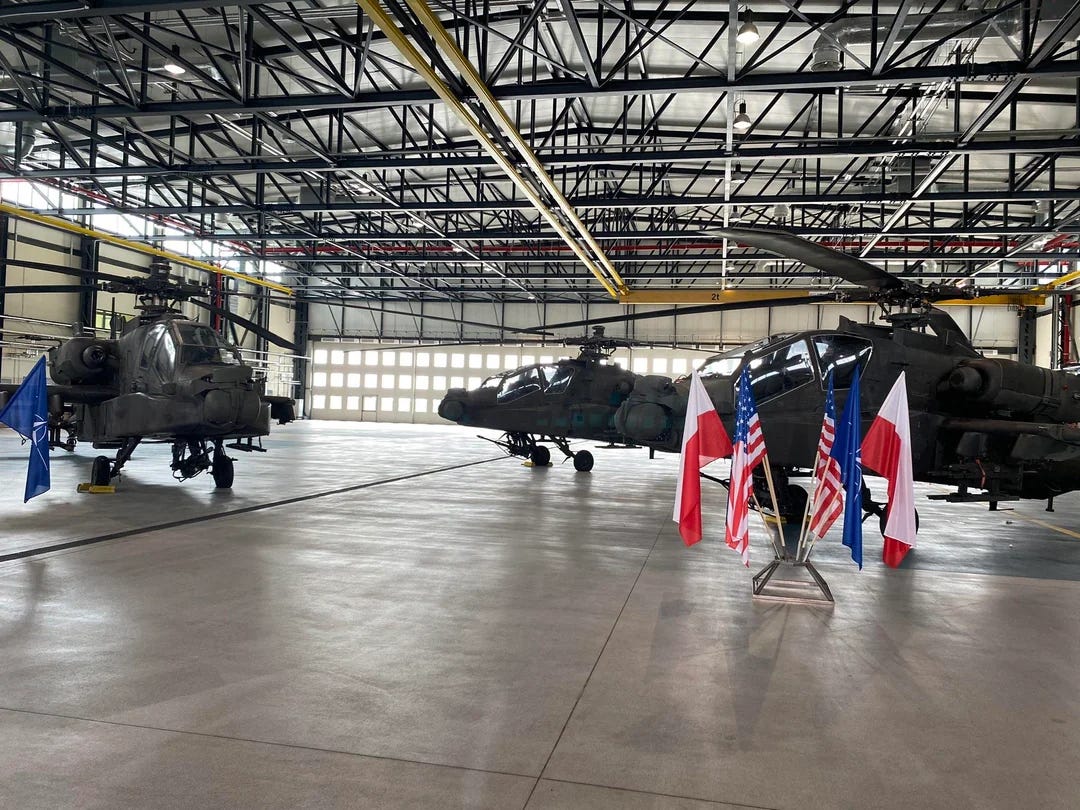

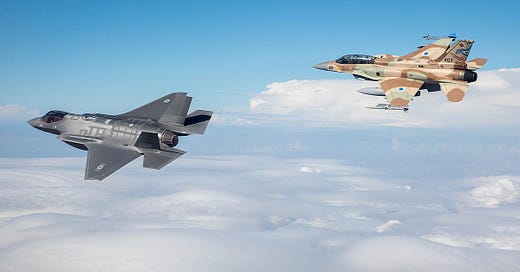


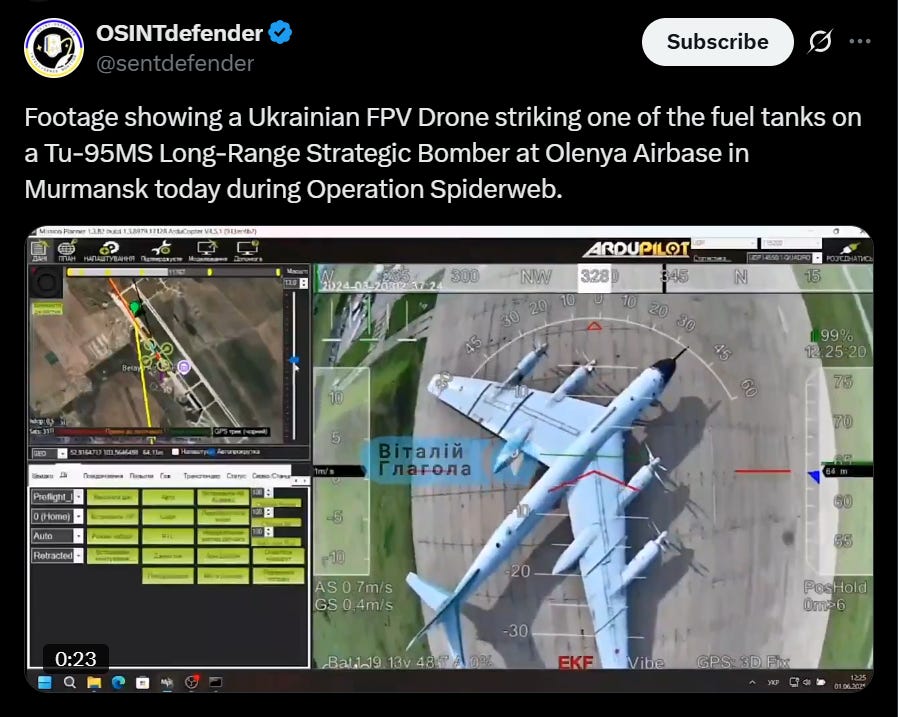




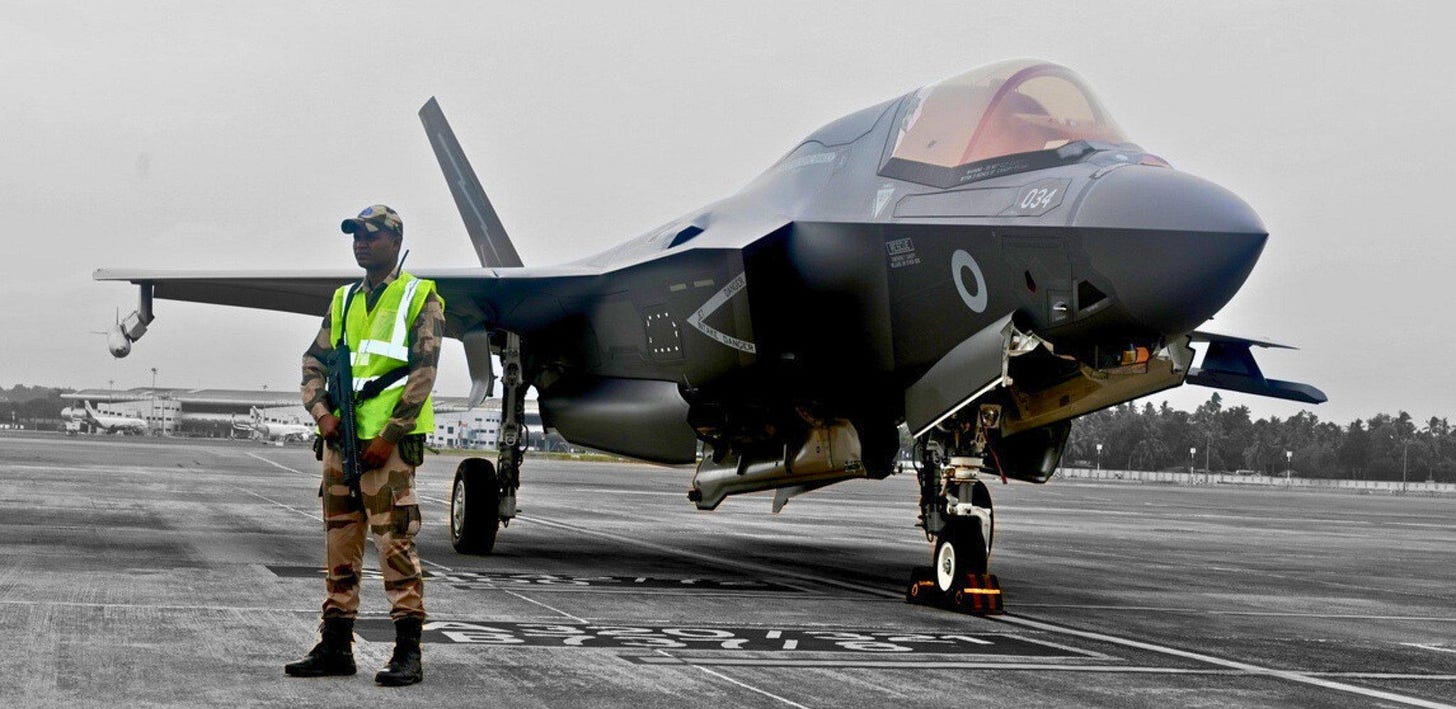
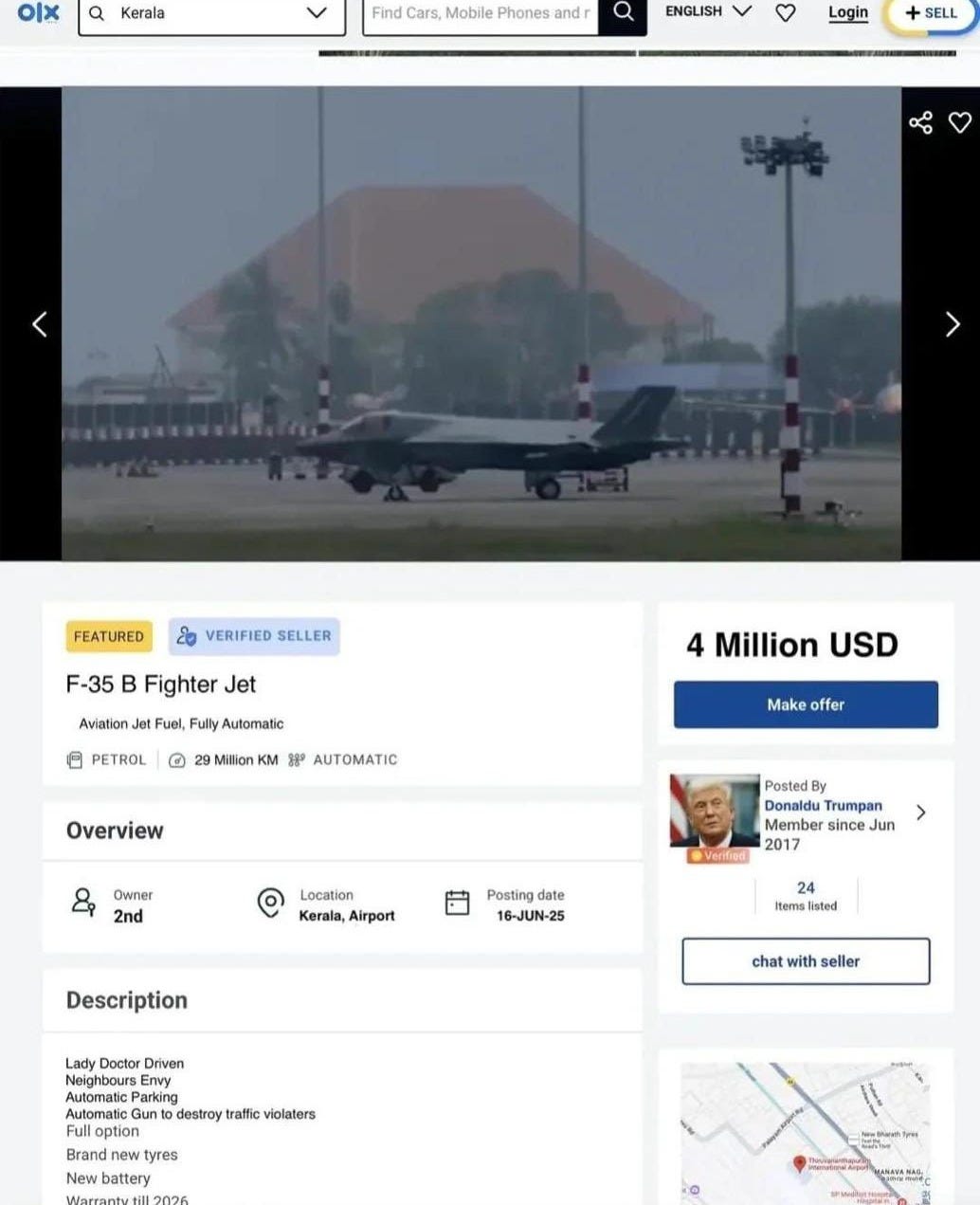
Rohan - Welcome back! You have brought out the specific roles which only strong fighter fleet ( offensive airpower) can achieve. Iran had negligible airpower capability/ capacity, relying only on Msl based AD. Kudos to both the IAFs.
Where as Fighter aircrafts have won many battles by creating air superiority agaist enemy forces, military drones are relatively a new phenomenon. Loitering munitions have been effectively used in recent/ on - goings conflicts. So, these easy to design&manufacture, easy to maintain and easy to operate systems have made their own space in the Aerospace and have now become integral part of any Military force. In present day scenario, it will be unfair to compare the two.
Another important aspect, in the Indian context is that while fighter planes are only on the inventory of IAF and Navy, drones are being used by Indian Army also.And Army would like to encourage use of drones to its advantage.
Gp Capt PV Singh